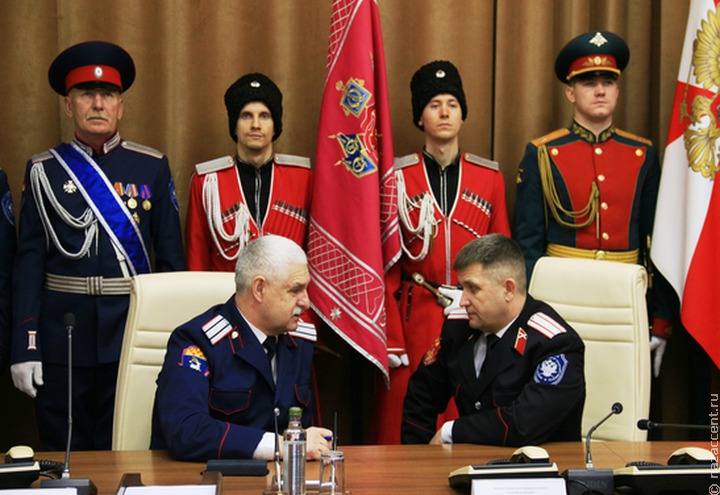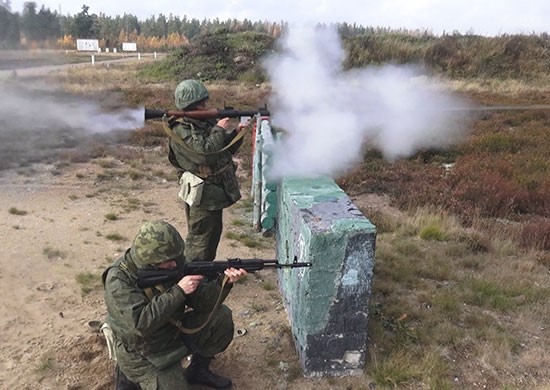
Russia’s BARS Reserve System Inducting Cossacks
By Dr Charles Bartles

Cossacks in Conference.

Reservists in training.

BARS servicemen in training.

BARS training site.
“[T]his year the mobilization reserve will include 1134 Cossacks: “A separate Cossack regiment will be formed with these reservists, and they will be commanded by Cossacks and wear Cossack uniforms.”
“In general, territorial defense companies staffed with reservists have been actively participating in the combat training activities of the district since 2016. One of them successfully completed the tasks according to the plans of the Zapad-2021 strategic exercise, which took place in the Western Military District…”
The accompanying excerpted article from the Southern Military District Press Service describes Russian plans to man its new reserve system with Cossack militiamen. The Cossacks are an ethnic group mostly found in Russia and Eastern Europe. Historically, Cossack communities were allowed self-governance in exchange for military service. Cossacks are no longer self-governing, but their tradition of military service continues in two forms. First, a few Russian military units are designated as “Cossack” units. These units are usually found in Cossack areas and only differ from regular units due to the honorific, such as the 205th Motorized Rifle Brigade (Cossack) of the 49th Combined Arms Army in the Southern Military District. The second form of Cossack military service is that of the Cossack militia. These militias are authorized by the Federal Law of the Russian Federation No. 154-FZ “On State Service of the Russian Cossacks” dated 5 December 2005. In practice, these militias are not usually equipped with firearms and are often used for crowd control and event security. One exception to this was in 2014, when Cossack units fought in the Donbass. Interestingly, there has been little reporting of Cossack exploits during Russia’s 2022 invasion of Ukraine. According to the Southern Military District Press Service article, Cossacks from the Terek Military Cossack Host will form a separate regiment of 1,134 personnel. The inclusion of Cossacks into the reserve system could provide Russia with the capability to put many more boots on the ground in Ukraine, if needed. (See: “Russia’s BARS Reserve System Takes Shape,” OE Watch #4, 2022; and “Developments in Russia’s BARS System,” OE Watch #1, 2022).
Sources:
“Терские Казаки Войдут в Барс (The Terek Cossacks Will Join BARS)”, Southern Military District Press Service (press service of the Southern Military District), 2 March 2022. https://tinyurl.com/bddy3tpa
The Cossacks of the Stavropol District Cossack Host of the Terek Military Cossack Host will join country’s reserve system (BARS) as part of a separate Cossack regiment. The Terek atamans discussed the formation of a mobilization human reserve…
The atamans of the Great Don Army, Kuban, Terek, and Black Sea Military Cossack Hosts confirmed their readiness to join BARS in mid-February by signing an agreement on attracting “members of the societies as candidates for the mobilization manpower reserve of the Armed Forces of the Russian Federation” with the Ministry of Defense.
The document implies the provision of assistance to the military in recruiting the mobilization manpower reserve with Cossacks: “Atamans of the Cossack societies confirmed their readiness to ensure the selection of personnel to serve in the country’s reserve system (BARS)…at least 50 percent of the Cossacks will be registered with the military and meet the criteria for being in the mobilization human reserve”…According to the press service of the Committee of the Stavropol Territory for Nationalities and Cossacks, this year the mobilization reserve will include 1134 Cossacks: “A separate Cossack regiment will be formed with these reservists, and they will be commanded by Cossacks and wear Cossack uniforms.”
Source: V Sosnitsky, “БАРС Отбирает Надежных Бойцов (BARS Selects Reliable Fighters) Armeisky Sbornik (monthly journal of the Russian Ministry of Defense), April 2022. https://rucont.ru/efd/317658
…In general, territorial defense companies staffed with reservists have been actively participating in the combat training activities of the district since 2016. One of them successfully completed the tasks according to the plans of the Zapad-2021 strategic exercise, which took place in the Western Military District…
As Colonel Igor Yegorov, military commissar of the Rostov Region, explained, the military enlistment office of the region stood at the origins of the creation of a mobilization manpower reserve in the Armed Forces of the Russian Federation. Since 2015, he has been taking part in an experiment to introduce a new system of troop recruitment by citizens who signed a contract to stay in the mobilization manpower reserve. In connection with the decision by the Supreme Commander-in-Chief of the Armed Forces of the Russian Federation to increase the size of the mobilization reserve, at present the assignment for the selection of reservists to the military commissariat of the region is almost 5,000…
According to the training curricula, the reservists will have monthly training sessions for 2-3 days and military training once a year, as a rule, for 20 days. At training sessions and military training, reserve fighters will learn how to shoot from all types of weapons and drive military equipment, and other practical actions in their combat specialties…As for the specific use of territorial troops, in the formation of which the Southern Military District has real experience, in the event of mobilization, their task, most likely, will be the protection and defense of especially important military facilities, defending rear areas, maintaining law and order in populated areas, and providing assistance to the local population during evacuation. If reservists accomplish these tasks, active-duty personnel and subunits need not be diverted for such duties.
Image Information:
Image: Cossacks in Conference
Source: Russian Ministry of Defense, https://tinyurl.com/46jrsn8j
Attribution: CC BY 4.0
Image: Reservists in training
Source: Russian Ministry of Defense, https://function.mil.ru/images/upload/2019/rezerv_550.jpg
Attribution: CC BY 4.0
Image: BARS servicemen in training
Source: Russian Ministry of Defense, https://tinyurl.com/2mvuschv
Attribution: CC BY 4.0
Image: BARS training site
Source: Russian Ministry of Defense, https://function.mil.ru/images/upload/2019/UVO1_29.08.21_550.JPG
Attribution: CC BY 4.0
Distribution A: Approved for public release
Categories:
Tags:







